How I Do It: Writing IEP Goals for Students Who Use AAC with Lauren Enders
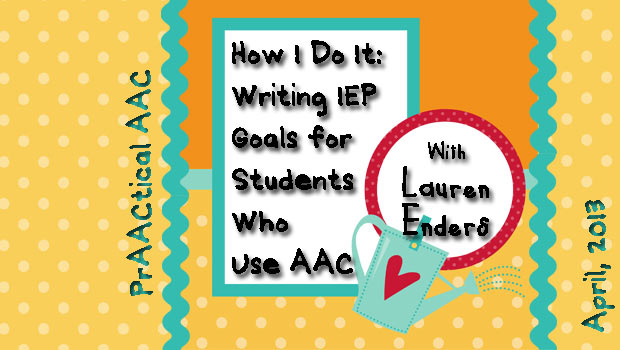
We’re so happy to welcome Lauren Enders back to share some more thoughts on AAC and the IEP. In her first post on this topic, Lauren addressed some frequently asked questions. Today, she provides a very valuable perspective on writing IEP goals for students who use or need AAC and some wonderful resources.
Very often, I receive requests for support from teachers and speech therapists that are writing IEP goals for their students who use AAC. When we sit down to discuss their questions, the first thing I remind them is that AAC goals are no different from any other IEP goal. I recall a workshop I attended years ago presented by Gail VanTatenhove that helps put IEP goals for AAC into perspective. Gail said that AAC therapy is just language therapy. Isn’t that true? Aren’t we just teaching language? For this student, language is simply being expressed in a mode other than natural speech!
What is different and I believe most daunting about the goal-writing process is that teachers and therapists simply don’t know enough about AAC. Most receive minimal instruction on AAC and educating students with complex communication needs. Therefore, most haven’t been given the tools to understand where to begin, what vocabulary to choose, how to teach AAC use, how develop appropriate and engaging activities, or how to write functional AAC goals. While we can’t go through all of those concerns in this post, I can offer some resources and lay out a blueprint to aid in the development of sound, measurable goals for your students who use AAC.
1. HOW TO CHOOSE VOCABULARY AND LANGUAGE SKILLS TO TARGET
This is surely the toughest step for most folks who write AAC goals and the answer is far from clear-cut. However, there are some steps we can take to help identify the most important learning targets for our students who are learning to use AAC.
A: Try to select vocabulary and language structures that will help the student establish and maintain meaningful communicative interactions.
For a great start on thinking about goals that will make a difference for your student, check out Goals that Matter: Practical Thinking from PrAACtical AAC. Are vocabulary and tasks such as stating the current weather conditions, labeling shapes, or stating today’s month, date and year going to be essential to this child’s ability to express their thoughts, feelings, complaints, hopes or desires? Will they use them outside of morning circle? Probably not. With each potential goal, ask yourself these same questions.
Zangari, Ph.D., Carole. PrAACtical Goals That Matter. Oct. 11, 2012. Web. <https://praacticalaac.org/praactical/praactical-goals-that-matter/>.
Choose core words, words that we know comprise the bulk of all words spoken by natural speakers. You may also want to include some extended or “personal core” words, words that Gail VanTatenhove describes as “words that are ‘core’ to the child’s personal needs, like names of key people, places, and things”. In certain cases, you may also include some pre-stored messages for utterances that need to be quick, such as “I need to use the bathroom” or “What’s your name?” Be careful with pre-stored sentences, however, because use of only pre-stored sentences denies the student the ability to build a novel message. For more on pre-stored messages and when they can be effective, explore 5 Reasons for Using Pre-Stored Messages in AAC Systems. 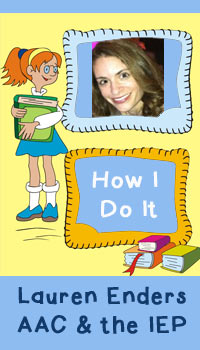
VanTatenhove, Gail M. Normal Language Development, Generative Language & AAC. 2005, Revised October 2007. Web. <http://www.vantatenhove.com/files/NLDAAC.pdf>.
Zangari, Carole. 5 Reasons for Using Pre-Stored Messages in AAC Systems. April. 16, 2013. Web. < https://praacticalaac.org/praactical/5-reasons-for-using-pre-stored-messages-in-aac-systems>.
TARGETS FOR BEGINNING COMMUNICATORS: If your student is a beginning communicator, select words like those included by Dr. Robin Parker in The First 12: Getting Started with Core Words (go, want, more, different, big, on, what, it, that, not, you, play). Alternatively, choose core words listed in the 4×6 script cards developed by Gail VanTatenhove which are available for download on Minspeak.com (what, look, help, all gone, more, do, again, all done, different, stop). These two lists are only examples. The key is choosing core vocabulary with lots of communicative power. Even children in the earliest stages of learning who use a single message voice output device can make meaningful contributions with the right vocabulary. For example, “go” can mean “go” get it, “go” start the toy, “go” push the buzzer, “go” hide, “go” away, etc. A noun like “cookie”, on the other hand, is much more limiting. Using the word “cookie” as an early developing word only indicates “cookie”. It doesn’t tell you whether they want a cookie, are all done with the cookies, want a different cookie, and so on. There’s nothing wrong with having additional choice boards with pictures of these motivating items or activities, but if you fill up a communication display with those words, the child will have nothing available to describe life experiences, make comments, etc.
TARGETS FOR MORE ADVANCED COMMUNICATORS: If your student has some of the basic core or extended words down and needs to expand his/her language, identify the complexity of their language structure using a tool like Gail VanTatenhove’s Normal Language Development, Generative Language & AAC. (NLDAAC) handout. Identify the skills they already have and select the words and/or level of language complexity that should be developing at the same time or next in typical developmental progression.
B: Consider the communicative function for the goal.
When writing goals for students who use AAC, I like to identify the function of language I want the student to learn. Once again in her NLDAAC handout, Gail VanTatenhove lists the various functions of communication (i.e., making comments, stating directives, naming/labeling) at single-word and two-word utterance levels. She also provides very helpful examples of how each function can be expressed using core words.
VanTatenhove, Gail M. Normal Language Development, Generative Language & AAC. 2005, Revised October 2007. Web. <http://www.vantatenhove.com/files/NLDAAC.pdf>.
A mistake I see repeated frequently is targeting only requesting (“wants and needs”). Other than our kids with the most significant motor impairments, when we create situations to force kids to ask for “things”, we are actually slowing them down. They can often get the item themselves. In these cases, how can we expect the child to be motivated by the task? In addition, making the child request items makes the assumption that they truly want that item. What if they don’t? In many cases, we need to focus instead on giving kids CONTROL. We need to help them to learn that communication brings power over others in their world. Feeling of power and control is a wonderful motivator for kids who tend to have so little control in their lives.
COMMUNICATIVE FUNCTIONS FOR BEGINNING COMMUNICATORS – I find that directives (such as “go”, “stop”, and “different”) are often a good place to start because they are helpful in teaching the student about the power of communication. They are concrete. When they say “go”, you go (e.g., run in circles, begin to push a toy car, or go away). When they say “stop”, you stop. When teaching ANY function of language, it’s essential to provide intensive modeling of the desired communication behavior in the mode you want the student to use. In AAC, we call modeling use of communication with the symbols and words we expect them to use aided language stimulation (or input). Check out Dr. Zangari’s post Tell Me About It: Focused Language Stimulation In AAC Vocabulary for more information on aided language stimulation. In my experience, the level of communicative success realized by augmented communicators is directly related to the amount of aided language stimulation they receive. More aided language input fosters greater language development. Another element of a successful AAC implementation plan is the creation of many opportunities for practicing new communication skills in as many contexts as possible throughout the school day. Some kids will need only a few models and times to practice while others may need hundreds or even thousands.
COMMUNICATIVE FUNCTIONS FOR MORE ADVANCED COMMUNICATORS: Once again, determine the functions of language already used by your student and add to those functions with those they are not yet demonstrating. For example, for a student who is requesting, directing actions, and labeling, target another function of language, like requesting assistance, requesting recurrence, or providing associations.
2. INCLUDE LEVEL OF PROMPTING IN THE GOAL
Be sure to include the level of prompting allowed during measurement of the goal. The prompting hierarchy that will be used should be clearly identified in the IEP and the goal should clearly specify the level of prompting allowed for the goal to be considered achieved.
I like the prompting hierarchy created by Gail VanTatenhove that can be found in her wonderful set of cards that script teaching a set of early developing core words.
http://www.minspeak.com/teachers/documents/Module_1_Script_Cards_4_6.pdf
If the above prompt hierarchy was being used, a copy of the hierarchy should be included in the IEP (WITH the examples).
NOTE: With our students with the most complex communication needs, it may be appropriate to differentiate short-term objectives from the annual goal simply by achieving the target skill with greater independence (a lower level of prompting).
3. BACK TO BASICS: INCLUDE THE ESSENTIAL COMPONENTS OF A GOOD IEP GOAL: Just a refresher…An IEP goal for AAC should have the same components as any other well-written IEP goal. “IEP goals need to be objectively measurable (that means observable) and must have a baseline. A baseline is an assessment of the student’s current ability to complete the IEP goal. A student’s progress towards an IEP goal is measured against the student’s baseline.”*
Every good IEP goal and objective should be a SMART one.
S – SPECIFIC – specifically describe the skill or expected behavior as well as conditions such as tools used or amount of prompting allowed
M – MEASURABLE –describe how student progress can be measured via counting or observation
A –Use ACTION WORDS – use action words like the student “will”
R – REALISTIC & RELEVANT consider the child’s disability, his or her needs, and the contexts of educational service delivery. For example, in many IEP goals for students with milder learning differences, we write across three consecutive sessions. Considering the inconsistency of many of our AAC users as well as possibilities for absence due to medical issues, it may be more appropriate to set measurement of the target (for example) to two times per classroom activity.
T – TIME LIMITED – clearly state the time frames for expected mastery. One marking period? One IEP year?
*Corbin, Carl. “How to Survive a Due Process Hearing.” Perspectives on School-Based Issues 9.1 (2008): 5-12.
Note: Description of the student’s “AAC system” (a Specific element of the goal) may be made in the present educational levels and/or in specially designed instruction. For example, Tommy uses approximated signs for “yes” and “no”, a high-tech voice output device, paper choice boards, and a manual communication board that duplicates the vocabulary most frequently used on his voice output device. Tommy will use the manual board when the device is not working or available or the environment does not support use of the device (i.e., bright sunlight or water play). When all of the elements that comprise Tommy’s AAC system have been described elsewhere in the IEP, the goal can simply refer to his “AAC system” unless the goal is specific to one mode of communication. The team can also choose to describe the system within the goal. Refer to your district’s policies to determine where you should list the AAC system components.
EARLIEST COMMUNICATOR: To increase classroom participation and involvement by the end of the one-year IEP period, Tommy will direct the action of the teacher or peer using his AAC system (a single-switch voice output device or single 2” symbol on paper) by using the word “go” or “stop” given a level 1 prompt (general statement: “If I hear “go”, I can start the blender.) and 10 seconds of wait time. He will use a target word 2 times per classroom activity in 4/5 opportunities. Baseline: Tommy requires a level 4 prompt to say “go” in classroom activities and does not yet use the word “stop”.
(Short-term Objectives may replicate this goal but allow for level 2 or 3 prompts and be measured after a shorter time frame, like a marking period).
EMERGENT COMMUNICATOR: By the end of the one-year IEP period, given 2 models and color coding cues for parts of speech (I need a blue word and an orange word) along with a level 2 prompt (general suggestion: “You can tell me what kind of animal”) plus 10 seconds of wait time, Susie will use her AAC system (a tablet-based device with a voice output communication app or a 50 location communication board with cells hidden to show only 20 locations) to describe a target item using an adjective and a noun 1 time per 15-minute classroom activity in 4/5 classroom activities. Baseline: Susie describes target items with a noun only with a level 2 prompt.
MORE ADVANCED COMMUNICATOR: By the end of the one-year IEP period, following 1 model along with a level 1 prompt (general suggestion: “tell me more in a sentence”) and 10 seconds of wait time, Johnny will use his AAC system (a tablet-based device with a voice output communication app or a 50 location core communication board with additional fringe in a flip book) to provide a one sentence response containing at least 3 words (subject verb object) 1 time per 30-minute classroom activity in 4/5 classroom activities. Baseline: Johnny provides 2 word sentences given a level 2 prompt.
For more information on SMART goal writing along with some examples, here’s a nice resource written by Peter W. D. Wright and Pamela Darr. http://www.readingrockets.org/article/24690/
Peter, Wright W.D., and Wright Pamela Darr. “SMART IEPs: Introduction.” Reading Rockets. N.p., n.d. Web. 17 Apr. 2013. <http://www.readingrockets.org/article/24690/>.
4. TEACH AND INTERACT, DON’T TEST! Offer LOTS of opportunities for practice in communicative contexts that are as natural as possible.
To ensure true understanding and support carryover, measure goals in natural communicative contexts as much as possible. When kids perceive communication as yet another demand or job, they more likely to shut down or lack the motivation to communicate. So, it’s best to work on a goal as part of a meaningful activity or exchange rather than in a drill (“Say ‘go’”!) format. Linda Burkhart and Gayle Porter make some insightful comments about natural contexts in their excellent handout Writing IEP Goals and Objectives for Authentic Communication – for Children with Complex Communication Needs. They state, “Goals must be measurable, but do not have to be measured in a testing format. It is often more appropriate to write the goal as measured over natural contexts throughout the day. For example, the child will ______ more than ___ number of times within the natural context of school activities. To make this type of data collection practical, reasonable time samples across days, weeks or months would need to be selected. For children who have very little expressive language, data might be collected every time the child expresses herself in the classroom. For the child who communicates only a few times a day, a full day may be selected periodically. For children who are using more language, a specific activity or time period of a selected day can be measured.”
Burkhart, Linda, and Porter, Gayle. Writing IEP Goals and Objectives for Authentic Communication – for Children with Complex Communication Needs. July 2009 and Feb, 2010. Web. <http://www.lburkhart.com/Writing%20IEP%20Goals%201%20hr%205%2010.pdf>
5. A TEMPLATE (OF SORTS) FOR WRITING AAC GOALS AND OBJECTIVES
I say “of sorts” because every district and state will have its own procedures and requirements. This template is meant to serve as a framework that you can tweak depending on your specific needs. The items listed after each component are simply examples and not an exhaustive list. The information listed should appear, but does not have to appear in the order I have shown.
Time Limit: By the end of the one-year IEP period, by the end of the 3rd marking period, at the conclusion of the second marking period
Specific Conditions: given ____ models, given _________cues, with a level ___ prompt, given _____seconds wait time, using ___________ AAC system (name system components if not named specifically in the body of the IEP or if your district requires the AAC system in the goal).
Action Words to describe targeted skill or behavior: the student will __________________
Measured by number of times performed: ______times, ____% of the trials
Realistic and Relevant schedule of assessment: per classroom session, across all activities, in ____/____ opportunities (Be sure to consider the number of possible opportunities that can be provided before selecting the number of expected behaviors! In some groups of students with the most complex bodies and communication needs, the response rates are very low. We wouldn’t want to write a goal for 5 responses per group in one of these classrooms because there may only be one opportunity.)
Baseline performance: ______ can currently _____________ with __________ conditions.
6. SOME SAMPLE GOALS OR OBJECTIVES FOR STUDENTS LEARNING TO USE AAC
In an effort to provide examples that support a larger cross section of students, I will separate the goals for learning AAC into the 4 areas of communicative competence. I will include goals for beginning communicators as well as more advanced communicators. Remember, short-term objectives may sometimes be variations of the annual goal with incremental differences in level of prompting.
LINGUISTIC COMPETENCE (competent use of vocabulary and syntax with AAC system)
LINGUISTIC COMPETENCE FOR A BEGINNING COMMUNICATOR:
By the end of the one-year IEP period, following 2 models and a level 2 prompt (if you say “different,” we can change activities) and 10 seconds of wait time, Gina will use her AAC system (a low-tech 12 location voice output device or a 12 location manual board with vocabulary to match her voice output device) to request recurrence of an activity with the word “more”. She will use the target words 4 times in a 30-minute classroom activity in 4/5 opportunities. Baseline: Gina requires a level 4 prompt to use the word “more”.
LINGUISTIC COMPETENCE FOR A MORE ADVANCED COMMUNICATOR:
By the end of second marking period, given 1 model along with a level 1 prompt (general suggestion: “tell me more in a sentence”) and 10 seconds of wait time, Sally will use her AAC system (a high tech dedicated with a voice output communication device or a 50 location core communication board with additional fringe in a flip book) to provide a 2 sentence response containing at least 4 words (subject verb article object) 1 time per 30-minute classroom activity in 4/5 opportunities. Baseline: Sally provides two 3-word sentences given a level 2 prompt.
SOCIAL COMPETENCE (competent use of AAC system to interact with others)
SOCIAL COMPETENCE FOR A BEGINNING COMMUNICATOR: To increase self-advocacy by the end of the one-year IEP period, Joey will request assistance with an object or action (when a needed item is missing, inaccessible, or broken) using his AAC system by using the word “help” or “open” given a level 1 prompt (general statement: “If I hear “help”, I can give you what you need) and 10 seconds of wait time. He will use a target word 2 times per classroom activity in 4/5 opportunities. Baseline: Joey requires a level 4 prompt to say “help” or “open” during classroom activities when a needed item is missing, inaccessible, or broken.
SOCIAL COMPETENCE FOR A MORE ADVANCED COMMUNICATOR: To increase peer interaction by the end of the one-year IEP period, following a model and given a level 1 prompt (general suggestion: take two turns) Mark will provide an on-topic utterance to maintain a conversational exchange for 2 turns using his AAC system (a tablet-based device with a communication app or a 50 location core communication board with additional fringe in a flip book) on 2 occasions per peer interaction activity in each of 3 consecutive data collection sessions. Baseline: Mark requires a level 3 prompt to answer a question or respond initially to a comment of a peer but does not respond for his second turn without a level 4 prompt.
STRATEGIC COMPETENCE (using AAC system competently with strategies for problem-solving within ongoing activities)
STRATEGIC COMPETENCE FOR A BEGINNING COMMUNICATOR: By the end of the one-year IEP period, following a communication breakdown and provision of a level 2 prompt (if you say tell me the word, I’ll understand”) plus 10 seconds of wait time, Mary will use her AAC system (a low-tech 8 location voice output device or an 8 location manual board with vocabulary to match her voice output device) to select a word to repair the communication breakdown. She will use her AAC system to repair a breakdown in 4/5 observed opportunities. Baseline: Mary requires a level 4 prompt to use her AAC system during communication breakdowns.
STRATEGIC COMPETENCE FOR A MORE ADVANCED COMMUNICATOR: By the end of the one-year IEP period, following a communication breakdown when using sign with a non-signer, given a level 1 prompt (I didn’t understand) and 10 seconds of wait time, Ben will use his AAC system (a tablet-based device with a communication app or a 50 location core communication board with additional fringe in a flip book) to successfully repair the communication breakdown. He will use his AAC system to repair a breakdown in 4/5 observed opportunities. Baseline: Ben requires a level 3 prompt to use his AAC system during communication breakdowns.
OPERATIONAL COMPETENCE (competent use of the AAC tools or devices)
OPERATIONAL COMPETENCE FOR A BEGINNING COMMUNICATOR: Upon completion of two marking periods, following a question posed by an adult and provision of 10 seconds of wait time, Jamie will use her AAC system (a dynamic display device with synthesized speech output) to respond to the question by navigating to one screen beyond the home screen and selecting an on-topic response 2 times in a 30-minute classroom or therapy session across each of 3 consecutive data collection points. Baseline: Jamie requires a level 2 prompt to navigate from the home screen to an on-topic responses.
OPERATIONAL COMPETENCE FOR A MORE ADVANCED COMMUNICATOR: Following completion of one marking period, when entering a loud room such as a cafeteria or busy classroom, given a level 1 prompt (general prompt “It’s loud in here!”) John will independently increase the volume on his AAC system (a high-tech dynamic display device accessed via eye gaze) in each of 3 consecutive opportunities. Baseline: John requires a level 3 prompt (“Turn up your volume, John”) to navigate to and increase the volume.
Looking for more support with goal writing for AAC? Here is some more information from the web: http://www.scoop.it/t/writing-iep-goals-for-aac-users
Filed under: PrAACtical Thinking
Tagged With: classroom, goal setting, goals, How I Do It, IEP, Lauren Enders, schools
This post was written by Carole Zangari
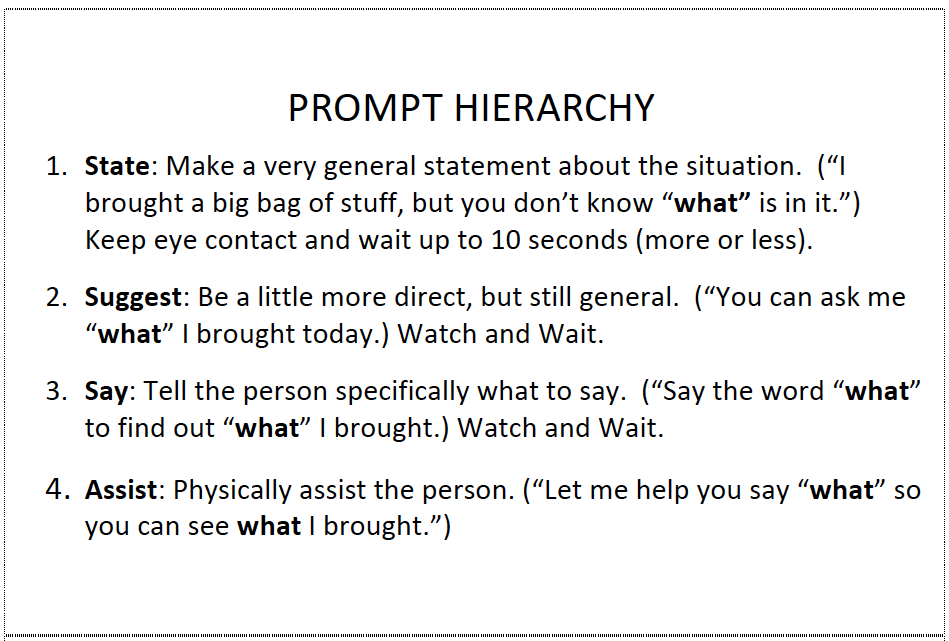


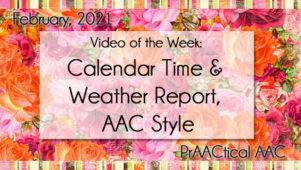
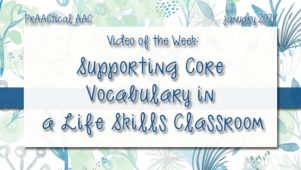
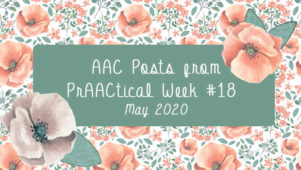

6 Comments
This is an amazing resource. Thank you so much for a great article and all of the super links!! Much appreciated!!
Ann
You are awesome! Thanks for the information!
Is there a way to get access to Gayle’s Language Development? The link is broken. Thank you!
I have concerns about the post above stating to provide physical prompts to a person to say “what” to be able to see “what” is in the bag. What if the person does not want to see what is in the bag? You just forced them to communicate. That doesn’t seem ethical to me. My son with ASD is currently using an SGD and we requested that our district never use physical prompts for exactly this reason.
What about the kids who are all about the noun? There are children who will not use core and there are some who aren’t , even after years of work, that great at it. For some kids it boils down to what is going to get their message across faster. Spending 10 seconds on core words or 2 seconds using pre-stored phrases or questions.
One communication function I think should be emphasized more often is rejecting. I know it’s cynical, but I suspect that a big reason it tends to be low on the list is that it’s more convenient for teachers and aides if the student isn’t able to refuse whatever they want the student to do. But for many students, rejecting is the one communication function that could have the biggest positive impact on their own well-being and quality of life, as well as the biggest impact in terms of preventing unpleasant behaviour (which is *very* often motivated by wanting to reject something, or else a distress response to something they would have rejected if they could). After all, if your options are to have a child saying “stop” with their device or by pulling your hair, it seems obvious which option is better for everyone involved.